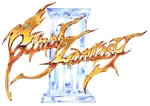Template:Sideicon Template:Infobox CVG
- For the game once released as Final Fantasy III in North America, see: Final Fantasy VI.
Final Fantasy III is the third installment in the Final Fantasy series, developed by Square Co., Ltd., and released on the Nintendo Family Computer (Famicom). It was officially released outside of Japan for the first time when it was remade for the Nintendo DS.
Up until 2006, Final Fantasy III was the only installment in the series to have never seen official English localization, and the only one of the early numbered Final Fantasy games to not see a port or remake. There had been an earlier plan to remake the game for Bandai's WonderSwan Color handheld, but the developers faced difficulties converting the original Famicom Version's cartridge size to the WonderSwan Color, leading to several delays and eventually cancellation after the platform's premature death. An enhanced remake for the Nintendo DS handheld system was released in 2006 in Japan and the U.S., and subsequently released in other parts of the world in 2007. In 2011, the DS version was ported on iOS with improved graphics. In 2012, the DS version was ported to the PSP with several new features. Also in 2012, the iOS Version was ported to Android and a version was a launch title for the Ouya console.[1] At the end of 2013, an Xbox-enabled version of the game was released for Windows Phone devices. On May 27, 2014, a PC port with upgraded graphics was released on Steam.
Final Fantasy III was scored by Nobuo Uematsu, and it is Uematsu's twenty-first video game music composition.
Gameplay
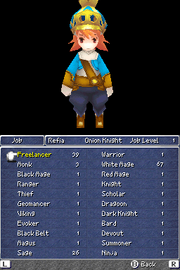
Job class selection in the DS version.
The gameplay contains elements of the first two Final Fantasy games, along with some new features. The Experience point system featured in the original Final Fantasy makes a return following its absence from Final Fantasy II. Final Fantasy III has a new class system; unlike the original Final Fantasy, where the player chooses each character's class at the start of the game, and Final Fantasy II, that has no specific classes, Final Fantasy III introduces the Job System the series would later become famous for.
Out of all four party members and all 23 Jobs in the game, there are 14,950 different party configurations. The Jobs are interchangeable classes: all four characters, the Warriors of the Light, start out as either "Onion Knights" (in the Famicom Version) or "Freelancers" (in the DS, PSP, smartphone, and Steam remakes), and are given the option to switch to a variety of other classes as more crystals are found and sidequests are completed. The classes featured in Final Fantasy III are:
| Physical-Oriented Jobs | Magic-Oriented Jobs |
|---|---|
| Onion Knight | White Mage |
| Freelancer*Remake-exclusive | Black Mage |
| Warrior | Red Mage |
| Monk | Scholar |
| Ranger | Geomancer |
| Knight | Evoker |
| Thief | Bard |
| Dragoon | Devout |
| Viking | Magus |
| Dark Knight | Summoner |
| Black Belt | Sage |
| Ninja |
Final Fantasy III is the first game in the series to feature special battle commands other than Magic, such as Steal or Jump, and each is associated with a particular Job. It is also the first game in the series to feature summoned creatures.
Characters
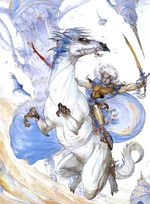
Nameless warrior, Artwork by Yoshitaka Amano.
In the game's original Famicom Version the player controls four generic Light Warriors, four children without distinct identities, who, upon finding the Wind Crystal, are granted its power to save the world. Though their genders are never made note of, it is assumed all the children are male. Over the course of their journey, the Light Warriors are joined by several support characters who join the party, but do not actually fight; instead, they offer help on the World Map.
The remake gives the four protagonists different personalities and names than the ones featured in the official manga. They are given different back-stories, which are used in several places to accelerate the plot. The main character is Luneth, who, after being tasked with saving the world's crystals, heads forth with his best friend Arc in pursuit of his quest. Shortly after setting out, they meet a blacksmith's daughter, Refia, and a Knight of Sasune, Ingus. Supporting characters, such as Cid and Sara, still join the party, but now randomly help the party in battle, either by attacking monsters according to their specialization, or by healing the party.
Although the Onion Knights are not named in the Famicom Version, the manga serialization, Yuukyuu no Kaze Densetsu: Final Fantasy III Yori, names them Muuchi (ムウチ), Doug (ダグ), J. Bowie (J・ボウイ), and Melfi (メルフィ), the only female in the group. In the screenshots of the original game seen in the Dissidia Ultimania, the Onion Knights are given the names of the main characters from the Remake Version.
Both versions of the game's logo, and several of Yoshitaka Amano's artwork, show a white-haired, muscular warrior. This character is never named and never appears in the game. His design is strikingly similar to later Amano drawings of the protagonist of Final Fantasy V, Bartz Klauser. His ponytail and longsword are also similar to that of Desch's character in the Remake Version of Final Fantasy III. His general appearance resembles Luneth. Many assume the unnamed warrior is the basis for Luneth's design.
Story
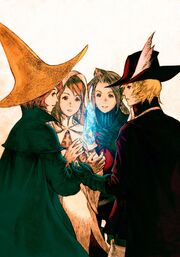
Warriors of the Light; Arc, Refia, Luneth, and Ingus.
The Gulgan thus prophesied: "The earthquake was only the beginning. The great tremors that swallowed the crystals, the light of our world, only to spawn monsters from the depths of the scarred land, are nothing but harbingers of what has yet to come. Something is coming...fathomless, ominous, and full of sorrow... But hope is not yet lost. Four souls will be blessed with light, and so it shall begin..."
Prologue, DS Instruction Booklet
Centuries ago the Ancients used the Crystals of light to build an advanced civilization, accidentally flooding the world with light. Four Warriors of Darkness were selected to restore the balance, but the Ancients' civilization fell into ruin. The Gulgans predicted that history would repeat and that four Warriors of the Light would be appointed to stop a flood of darkness.
One day, an earthquake opens up an entrance to Altar Cave near the village of Ur. Four orphaned youths under the care of Topapa, the village elder, explore and find the Crystal of Wind. The crystal grants them a portion of its power and their first set of Jobs, instructing them to go forth and restore world balance.
In the Remake, only Luneth falls into the cave and is told to find the other Warriors before being granted the Crystal's power. He and his friend Arc visit Kazus, the village cursed by the Djinn. They find Refia in Cid's Airship, and all three journey to Castle Sasune to see the King and retrieve the Mythril Ring needed to break the curse. They are granted access by the royal guard Ingus, who becomes their fourth companion. The King tells them to rescue his daughter, Princess Sara Altney, assuming the Djinn has abducted her, and gives them a folding canoe.
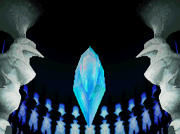
The Crystal speaks to the party.
They enter the Sealed Cave and meet Princess Sara, who left with the ring to stop the Djinn. With her help they defeat him. She returns to the castle while Luneth, Arc, Refia, and Ingus are transported to the Altar Cave, where the Wind Crystal appoints them Warriors of the Light and gives them their first set of Jobs.
Back at Castle Sasune Princess Sara uses the Mythril Ring to break the curse. The warriors say farewell, Ingus promising to return to visit Sara, and then return to Cid in Kazus. He uses his airship to clear the boulder blocking the mountain pass to the rest of the continent, but it comes at the cost of the airship, forcing them to travel on foot. They journey to the town of Canaan and heal Mrs. Cid of an illness, then meet a girl named Salina. She mourns the disappearance of her love, Desch. Since the party needs to find Desch for the Mini spell they go to find him on Dragon's Peak. Bahamut abducts the Warriors to feed his offspring, but they meet Desch in the dragon's nest and escape. He has lost his memory and joins the Warriors in hopes of regaining it.
Using Desch's Mini spell, the group enters Tozus, the village of the gnomes. They pass through Tozus Tunnel to reach Vikings' Cove so they can acquire a ship. They find the Vikings in an uproar as their guardian, the Nepto Dragon, is on a rampage and sinking ships. The party agrees to help.
They journey to the Nepto Temple and find the statue of the Nepto Dragon is missing an eye. They shrink down to traverse the tunnels inside the Temple walls and find the missing eye in the horde of a rat. They return the eye to the statue, which calms the dragon. In gratitude, the Vikings give them the ship Enterprise.
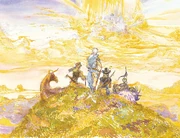
Yoshitaka Amano's Warriors of the Light.
The Warriors of the Light use the Enterprise to explore. They travel to the Village of the Ancients and learn the continent they are on is actually floating above the "surface world." They visit Gulgan Gulch, where the Gulgans tell them to go to the Tower of Owen. They battle through the tower while a mysterious voice taunts them. The top they find Medusa, servant of Xande, threatening to bring down the floating continent by destroying the tower. After defeating her, Desch's memory returns. He recalls he is one of the ancients who was the Guardian of the Tower and leaps into the furnace to save the floating continent.
The maelstrom blocking the channel north clears, so the party heads for Dwarven Hollows in search of the Fire Crystal. The dwarves are preoccupied because one of their precious ice horns was stolen by Gutsco the Rogue. The party enters the subterranean lake to recover it, making use of the Toad spell. After "defeating" him, they return to Dwarven Hallows, followed by a mysterious shadow. When they reach the main altar Gutsco reveals himself and grabs both horns.
The four pursue him, this time into the Molten Cave. Gutsco leads them to the Crystal of Fire and absorbs its power to become a dragon. After defeating Gutsco a second time, the party receives the light of the Fire Crystal and several additional Jobs, and returns the Horns of Ice. They obtain the Fang of Water here.
The four Warriors next sail to Tokkul, a village in ruins. They learn the evil Hein, adviser to King Argus, has captured the King, enslaved the people, and uprooted the Elder Tree from the Living Woods. They are attacked and kidnapped by Hein's men and taken to Castle Hein, which is actually the floating Elder Tree.
The Warriors of the Light defeat Hein and restore the Elder Tree, obtaining the Fang of Wind. Upon reaching Castle Argus the king welcomes them and thanks by giving them the Wheel of Time. They return to Cid who uses the Wheel to make the Enterprise into an airship and tells the four orphans the truth about their origins. They and Cid came from the surface world on Cid's airship, which crashed on the Floating Continent after running into a mysterious cloud. Most of the passengers were killed, and the four orphaned infants were adopted by Ur, Kazus, and Sasune. With this knowledge, the Warriors of the Light fly the airship off the edge of the floating continent.

The world covered in darkness.
The surface world is a swirling mess of darkness with two islands. They fly the Enterprise to a wrecked ship and find an old man tending to a water priestess named Aria Benett. They aid her with a Potion and she recovers. She recognizes them as the Warriors of the Light and joins them to restore the Water Crystal. Using a crystal shard she opens the way to the Cave of Tides. They make their way to the crystal, and Aria returns the shard and instructs the Warriors to return the light to the crystal. As they approach, Aria pushes Luneth out of the way of an arrow. She falls, and Kraken attacks the party. The four defeat him, but Aria is mortally wounded and an earthquake strikes as the darkness dissipates, forcing them to flee.
The party awakes in the Town of Amur and find that Goldor has chained up their ship. In town, they meet Four Old Men who believe themselves to be the Warriors of the Light. The party must rescue them from monsters in the sewers, and the old men repay them by helping them get Levigrass Shoes from the cantankerous Delilah. The party goes to Goldor Manor to get the chain's key and meet the Earth Crystal, but Goldor spitefully shatters the crystal after his defeat. Dismayed, the party unlocks their ship and sets out, visiting several towns elsewhere.
The Enterprise is shot down when they fly over the kingdom of Saronia, which is in the midst of a civil war caused by King Gorn. The army has been ordered to fight itself and shops everywhere are closed. They find the King's son, Prince Alus, in a pub, having been banished from the castle. Arc convinces the rest to aid him. They are permitted to enter the castle upon their return, but later that night, King Gorn enters the room to kill his son. Gorn plunges the knife into his stomach and frees himself from the spell placed upon him by his adviser, Gigameth. Gigameth turns into Garuda and the party defeats him. Alus is subsequently crowned as king.
Scholars tell the party the airship Nautilus has been unearthed. Using it, the party flies over the Dalg Continent to Doga's Manor where they meet the sage Doga and his moogle bodyguards. Doga explains that he, Unei, and Xande were once students of the great Magus Noah. Noah granted each of a gift: Doga was given vast magic power, Unei control over the world of dreams, and Xande was granted mortality. Xande was enraged and terrified at the prospect of death and drained the Water and Earth crystals to stop the flow of time creating the Floating Continent. Now he wishes to kill the Warriors of the Light to do so again. The party confesses their inability to save the Earth Crystal, but Doga informs them that the one Goldor had was a fake and the real Earth Crystal is unharmed. He joins their party and uses Mini on them to enter the Cave of the Circle. When they reach the end of the cave, Doga uses a spell to transform the Nautilus into a submarine and tells the Warriors of the Light to go to the Temple of Time and recover Noah's Lute, which will awaken Unei from her eternal slumber. He leaves the warriors to find the Eureka Key himself.
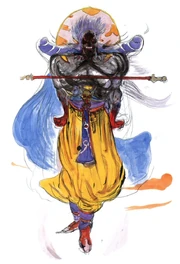
The sorcerer Xande.
The Warriors of the Light retrieve the lute and go to Unei's Shrine to awaken her. She gives them the Fang of Fire and tells them that the earthquake near Ur was not caused by Xande, so there must be a greater power at work. Unei joins the party and helps them excavate the Invincible, which can fly over mountains, from the Ancient Ruins. After briefing them on its capabilities, she bids them farewell and directs them to the Cave of Shadows for the final Fang.
The party defeats Hecatonchier and obtains the Fang of Earth; with all four fangs they can pass the statues Xande put up to protect his headquarters and reach the Ancient's Labyrinth. They fight Titan and meet the Crystal of Earth, which gives them their final set of Jobs. Doga and Unei call the Warriors back to Doga's Manor and teleport them into Doga's Grotto upon their arrival. The two sages explain that their souls are needed to activate the Eureka Key and the key to the Crystal Tower and order the party to kill them in battle. Although reluctant, the Warriors are given no choice. In the Remake, Doga and Unei grant them titles: Luneth is the Light of Courage, Arc the Light of Kindness, Refia the Light of Affection, and Ingus the Light of Determination.
The party returns to the Ancient Maze and passes through it to enter the Crystal Tower. There, they unlock the doorway to the Forbidden Land of Eureka and obtain the powerful weapons they need to fight Xande. When they return to the tower and reach the top, they are paralyzed by the curse of Five Wyrms. Doga's spirit brings the allies who fought alongside the Warriors of the Light to the tower to break the curse: Cid, Princess Sara, Desch (who survived the furnace), King Alus, and one of the Four Old Men. They wish the Warriors the best of luck after breaking the curse, and the Warriors go through the portal to the World of Darkness.

The Warriors fall.
When they face the Cloud of Darkness again, the four Warriors of the Dark sacrifice themselves to weaken the entity. The Cloud of Darkness is defeated, and the heroes and their allies return to their homes; the old man returns to Amur, Alus returns to his kingdom, and Cid and Desch return home to their lovers. Sara does not want to leave Ingus, and stays with him. Each of the heroes go their own ways, with Ingus and Sara returning to Castle Sasune, Refia taking up blacksmithing in Kazus, and Luneth and Arc returning to Ur. In the Famicom Version the Warriors of Light return to Ur together.
Development
Final Fantasy III is visually similar and uses a similar graphic system as Final Fantasy and Final Fantasy II. Final Fantasy III expands the gameplay with its introduction of the changeable Job system. Final Fantasy III is the first game in the series to feature auto-targeting; in the previous titles a character attacking an enemy that was killed by a previous attack, would simply attack nothing, and a message would read "ineffective".
The Famicom Version eliminates the previous games' text-heavy battle presentation. In the previous titles, attacks, spell names, damage registered, number of hits, and other info is displayed in cascading windows at the bottom of the screen. Final Fantasy III replaces this with damage being displayed on the enemy sprite after the attack.
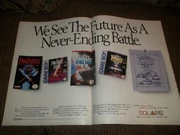
Old promotional poster that includes prototype cover artwork for the NES versions of Final Fantasy II and Final Fantasy III, neither of which were released in the US.
One notable stylistic change is that the background of all windows and menus is changed from black to blue, something that would become a staple. Another major gameplay enhancement is that Final Fantasy III is the first title in the series to feature characters who have unique action commands in battle, such as Summon, Throw, and Jump.
At the time of the release of Final Fantasy III Square were working to catch up on the new technology, as Super Nintendo had been released, that they didn't have enough manpower to work on an English version of Final Fantasy III.[2] Final Fantasy III is one of the largest RPGs developed for the NES/Famicom platform. The volume of content was so large the cartridge was completely full, and when new platforms emerged there wasn't enough storage space available for an update requiring new graphics, music and other content. This prevented Final Fantasy III from being remade for other systems in the intervening years, until it was remade entirely for Nintendo DS.[2]
Ports and Remakes
The Cancelled WonderSwan Color Version
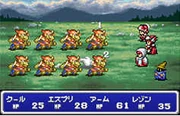
Screenshot of the cancelled WonderSwan Color version of Final Fantasy III.
December 1999 Bandai, the maker of the handheld WonderSwan Color console, struck a deal with Squaresoft to bring their games to the console. Among the first projects announced were the remakes of the first three Final Fantasy games. However, the Wonderswan version of Final Fantasy III never saw the light of day despite being shown on the official Squaresoft site. The Wonderswan version of Final Fantasy III was set to be released on December 2001, but never came out. While a port of Final Fantasy IV was released later, Square remained silent regarding Final Fantasy III. Although the game was never formally cancelled, the official website was taken offline once production of the WonderSwan Color consoles ceased in 2002.
When we developed FF3, the volume of content in the game was so huge that the cartridge was completely full," he says, "and when new platforms emerged, there simply wasn't enough storage space available for an update of FF3, because that would have required new graphics, music and other content. There was also a difficulty with how much manpower it would take to remake all of that content.
Hiromichi Tanaka in 2007 at Eurogamer
Nintendo DS Version

The first battle of Final Fantasy III in the Nintendo DS remake.
In 2004 it was decided to re-make Final Fantasy III and at first Square was considering developing it for PlayStation 2. However, Nintendo asked Square to make Final Fantasy III on their newest handheld console, Nintendo DS, instead.[2]
The Final Fantasy III Nintendo DS remake was first revealed to be in development on October 7, 2004, but detailed information did not emerge until a year later. Hiromichi Tanaka, one of the original game's main designers, was the head of the project as both the executive producer and director. His guidance and supervision was needed because the game was not meant to be a mere graphics update like the updates for Final Fantasy I & II: Dawn of Souls, but a total overhaul using the Nintendo DS's 3D capabilities, even though the layout of most dungeons and towns would remain identical to the original. Ryosuke Aiba, the art director of Final Fantasy XI, was hired as the new art director.
Akihiko Yoshida was hired to revamp the original character designs. The main characters were given backstories, personalities and default names: Luneth (Runesu), Arc (Arukuu), Refia (Refia), and Ingus (Inguzu). Even though the characters were given background and development, it does not change the main storyline.
Overhauls were made to the Job system, including the re-balancing of the classes, the addition of new abilities, the removal of Capacity Points, and a new "Bare" ("Freelancer" in the US Version) class as the new default Job class with the Onion Knight becoming a separate class. Unlike the original Famicom Version, most of the Jobs remain useful for the entire game; the ultimate Jobs, the Ninja and the Sage, are rebalanced to stay on the same level as the others.
Nintendo and Square worked closely on bringing Final Fantasy III to DS, but since it was the first time Square had made a game for the console they had to start from scratch. Square worked together with a company called Matrix Software, and used an original game engine created for Final Fantasy III.[2]
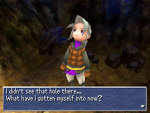
An early official screenshot of Luneth in the English version of the remake.
The game makes use of the DS's WiFi capabilities through an e-mail system known as "MogNet", in a nod to Final Fantasy IX's similar system, for players to exchange messages to each other through WiFi communications. Besides being a way to share thoughts, using Mognet can also be used to unlock and complete sidequests, as well as just send mail to the NPCs met on the way. The original libraries Nintendo gave Square didn't include a system for communicating with people who are offline - so Square made a new library for the DS allowing players to send a text letter, like an email, which is stored on a server and when the other person gets online, they receive the message.[2]
With the DS remake of Final Fantasy III Square wanted to keep both parties happy - the old fans in the Japanese market who played the original game, as well as the new players for whom the DS version would be the first touch with Final Fantasy III. For the old fans Square didn't want to offer huge changes, but for western players they didn't want it to feel like an old-fashioned game.[2]
The DS remake of Final Fantasy III was released in the United States on November 14, 2006. The game was released in Europe on May 4th, 2007. One of the biggest criticisms of the game was that the battles are remarkably different - the size of a DS game at the time imposed restrictions, and there are less enemies on the screen at any given fight. In addition to the overhauls in the job system, the enemies are made stronger to compensate for their decreased numbers. As such, quite a bit more level grinding is necessary even for boss monsters, which attack more frequently. By the release of the subsequent remake, Final Fantasy IV, the increased ROM size allowed the developers to retain the original number of enemies in a group.
Special Edition DS
On the same day Final Fantasy III was released, Square Enix began selling the bundle package with the game and a special Crystal White DS Lite. The DS has Akihiko Yoshida's artwork on the top of the system. The DS Lite was released in Japan only, and is shown with the Final Fantasy III logo and a few of the main characters emblazoned on the front.
iOS
Final Fantasy III was released for iOS 3.0+ devices on March 24, 2011, and is available for purchase exclusively via the Apple App Store. It is an enhanced port of the DS release, with the same characters and general design, but higher quality graphics and sound.
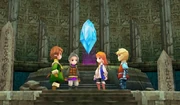
Final Fantasy III on the iOS.
The original DS Version runs at 256x192 on each display. The resolution for iOS release runs at either 480x320 or "Retina" display 960x640 native resolutions. The latter resolution is supported only on devices with the 960x640 "Retina" displays (iPhone 4, 4s, and iPod Touch 4th Generation). On the iPad, it is natively run at 1024x768. Graphical enhancements for the iPad had came out one month after with the release of an update on April 21st, 2011.
The release on iOS includes minor dialogue changes, such as the NPC explaining features and controls unique to iOS devices. The player controls the character actions via touch input since there are no physical buttons to use. For example, the ability to zoom in the camera with the L button in the Nintendo DS Version is done by using a two finger pinch gesture. The character movement is done by using an on-screen analog stick. The subtitle/dialogues font was changed with the dedicated iOS's system font (usually Helvetica, depending on what font you use if you have jailbroken device via BytaFont), more big and separated, easing the lecture.
Since the iPad, iPhone, and iPod Touch do not have two physical screens, iOS release forgoes what is displayed on the screen seen in the DS Version, but allows access to various functions through menus the player can access by touching buttons overlaid on the screen.
There is no internet-enabled functionality like its Nintendo DS counterpart, which uses the Nintendo WiFi Connection for Mognet to unlock a secret Job class. It is unknown if the iOS Version will gain internet functionality through Apple's Game Center (equivalent to Nintendo WiFi Connection) in a future update. Instead, the quest to acquire the Onion Knight can be completed after the events of the Fire Crystal.
In the iOS Version, it is possible to skip monsters due to an encounter glitch
On Febuary 6, 2014, the 1.6.0 update of the game was released. This adds the optimization of the 4-inch 1136x640 "Retina" displays (iPhone 5, 5c, 5s, and iPod touch 5th generation), added support for the Logitech PowerShell Controller + Battery, and minor bug fixes. This update now requires iOS devices running iOS 4.3 or later.
Android
According to its official page the Android Version features:
- New and improved 3D visuals and story sequences only for Android
- Smooth, intuitive touch-panel controls specifically tailored to Square Enix's smartphone RPGs
- Quicker browsing through the monster bestiary and other game records
- New visual designs for the Job Mastery Cards
[3] In the Android Version, it is possible to skip monsters due to an encounter glitch.
Android TV support was added on Nov. 3, 2014.[4]
PlayStation Portable
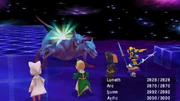
Final Fantasy III on PSP.
A trailer for a PlayStation Portable port of the DS Version appeared on Square Enix's YouTube page with the trailer concluding in a September 9, 2012 release date for Japan. The port features enhanced graphics, additional galleries and an option to use either the original or the arrangement music for the game. An auto battle mode is also included. The player may acquire the strongest equipment in the game through wireless connectivity. The game also includes the English script, making it import-friendly.
The PlayStation Portable Version of Final Fantasy III made to be available September 25th via the PlayStation Network and makes every numbered Final Fantasy title available in some form for a Sony platform.
Kindle Fire
On November 1st, 2012, Final Fantasy III was made available for Kindle Fire and Kindle Fire HD on the Amazon Appstore for $15.99.[5] This version is optimized for play on the Kindle Fire and Kindle Fire HD, and the touch-panel controls have been adjusted, making the game smoother and easier to play.
Ouya
The game was a launch title for the Android-based console Ouya. This release includes both remastered music and improved graphics.
Windows Phone
On 27 December 2013, Final Fantasy III was released on the Windows Phone Marketplace (with no marketing whatsoever). Like the WP version of the original Final Fantasy, it has 18 Xbox achievements, though they are all hidden until they are unlocked.
As with all Windows Phone apps, there is also a demo version of the game, which stretches from the beginning of the game up to the first visit to Castle Sasune when Ingus joins the party. After exiting the castle, a notification appears with a link to let players buy the full game or return to the title screen. If the player purchases the full game from this notification, their progress will resume from the world map.
Steam
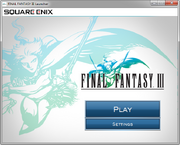
The Launcher menu.
Final Fantasy III launched on Steam with upgraded visuals, 18 achievements, Steam Trading Cards and new visual designs for the Job Mastery Cards. The game has been optimized for PC gaming and has quicker browsing through the bestiary. It is compatible with PCs running Microsoft Windows Vista, 7, and 8.
System Requirements
| Minimum | |
|---|---|
| OS | Windows Vista, 7, 8 |
| Processor | Pentium 4, 2.4 GHz |
| Memory | 2 GB RAM |
| Hard Drive | 800 MB available space |
Steam Trading Cards
The Steam version of Final Fantasy III comes with 9 Steam trading cards.
Template:Gallery
Novelization
As part of its Final Fantasy 25th anniversary celebration, Square Enix released a novelization of the first three Final Fantasy games. The novelization, titled Novel Final Fantasy I, II, III Memory of Heroes, was released in the fall of 2012.
Easter Eggs
- In the Famicom release, a little girl, hidden in an east room in the town of Gysahl, encourages the player to write inquiries to Square, listing out the mailing address.
- In Ur and Amur, there are pianos Luneth and friends can play, which will randomly cause either booing or applause.
Production Credits
Original Famicom Version
| Director | Hironobu Sakaguchi |
|---|---|
| Producer | Masafumi Miyamoto |
| Co-designers | Hiromichi Tanaka, Kazuhiko Aoki, Koichi Ishii |
| Programmers | Nasir Gebelli, Kiyoshi Yoshii, Katsuhisa Higuchi |
| Character & Graphic Design | Yoshitaka Amano |
| Co-writer | Kenji Terada |
| Composer | Nobuo Uematsu |
Remakes
| Director & Executive Producer | Hiromichi Tanaka |
|---|---|
| Producer | Tomoya Asano |
| Battle Supervisor | Kazuhiko Aoki |
| Main Planner | Hiroaki Yabuta |
| Programmers | Yuichi Yoshida, Shinnosuke Ohasi |
| Movie Director | Kazuyuki Ikumori |
| Art Director | Ryosuke Aiba |
| Character Design | Akihiko Yoshida |
| Image Illustrator | Yoshitaka Amano |
| Graphic Designers | Jin Yamuraa, Kango Sumi |
| Composer | Nobuo Uematsu |
| Music Arrangement | Tsuyoshi Sekito, Keiji Kawamori |
| English Translation | Aziz Hinoshita |
Packaging Artwork
Template:Gallery
Gallery
Template:See Also Template:Gallery
Trivia
- In the remake, there is a contradiction towards the story of how the four children came to be. According to Cid, the children were not originally from this world, stating that ten years prior to the game, he was ferrying people to and from the continents when an unknown evil struck, causing his ship to be destroyed. This contradicts what Unei says: that the Surface World had been closed off for a thousand years. However, this could be due to a time anomaly caused when the Surface World was engulfed in darkness; for all Cid knows, he could have been drifting aimlessly, frozen in time, for a thousand years, and the power of the crystals may have allowed his airship to drift into the Floating Continent, freeing him from being frozen in time.
- In 1999, Final Fantasy III was unofficially translated into English by Neill Corlett and Alex W. Jackson. In addition to this popular fan-translation, there exists an alternate complete one.
- This is the first game in the series where the playable characters are children.
- In the remake, upwards of 9999 damage can be dealt by every character, and although the game will only show 9999, it calculates according to the actual amount.
- Final Fantasy III was the first appearance of moogles and the fat chocobo in the series.
- The "circumnavigate the world on a Chocobo for reward" quest originates in Final Fantasy III, to be repeated in Final Fantasy V.
- Final Fantasy III was the first game in the series to graphically show hit points when a target is attacked or healed, rather than use caption as in the original versions of the previous two games. It is also the first to contain auto-targeting, as well as the first to contain special battle music for boss battles. All of these aspects were adapted in the remakes of the previous two games.
- The names of Doga and Unei, two key characters in Final Fantasy III, appear in multiple Final Fantasy games, including Final Fantasy IX, which contains a sub-quest involving two items named "Doga's Artifact" and "Une's Mirror". These items unlock a hidden theme titled "Doga and Une" in the Black Mage Village.
- Several of the game's songs were used in Chocobo Racing, including the opening theme ("Crystal Cave") and the final battle theme.
- Though most of the sprites for 8-Bit Theater are from the original Final Fantasy, many other sprites, including the new class changed Light Warriors, are game sprites from the Famicom Final Fantasy III.
- The original background music for the town of Amur was used in creating the song "Cloud Smiles" in Final Fantasy VII: Advent Children.
- The DS version was originally conceived with Luneth, Arc, Refia, and Ingus as the adopted children of Topapa, much like the NES version; this was changed to make the four characters have their own, separate, stories.
- In Final Fantasy 20th Anniversary and the Final Fantasy portion of Final Fantasy I & II: Dawn of Souls, the Two Headed Dragon, Echidna, Cerberus, and Ahriman appear as bosses in the optional Earthgift Shrine, with the "Battle 2" as BGM. In Final Fantasy IV: The After Years, they return as guardians for the crystals of the True Moon.
See Also
- Final Fantasy III Concept Art
- Final Fantasy III Translations
- Final Fantasy III Wallpapers
- Final Fantasy III Walkthroughs
External Links
- Final Fantasy III DS official site (Japanese)
- Final Fantasy III DS official site (North American)
- Final Fantasy III on iTunes Store
- Final Fantasy III on Google Play
- Final Fantasy III on Windows Phone Store
- Final Fantasy III on Steam
References
- ↑ http://www.forbes.com/sites/erikkain/2012/07/31/final-fantasy-iii-will-be-an-ouya-launch-title/
- ↑ 2.0 2.1 2.2 2.3 2.4 2.5 2.6 http://www.eurogamer.net/articles/fantasy-reborn-interview
- ↑ https://play.google.com/store/apps/details?id=com.square_enix.android_googleplay.FFIII_GP
- ↑ http://press.na.square-enix.com/releases/346
- ↑ http://na.square-enix.com/finalfantasyiii/go/article/view/final_fantasy_25th_anniversary/260735/final_fantasy_iii_available_on_kindle_fire
Template:FFIII Template:25thcompl Template:Series

